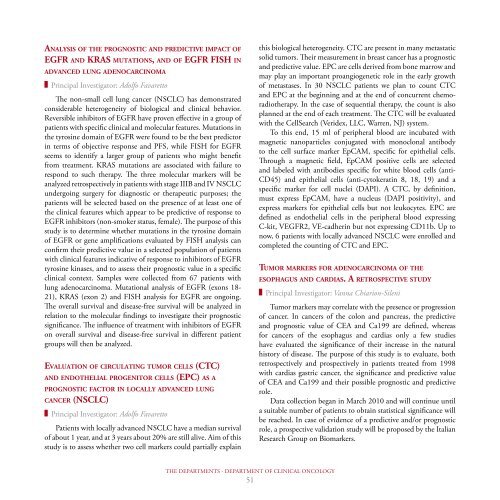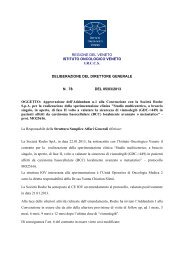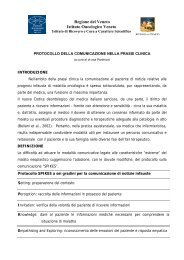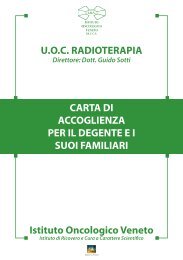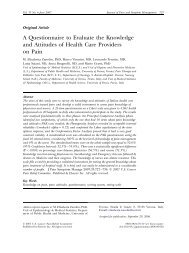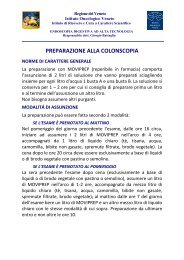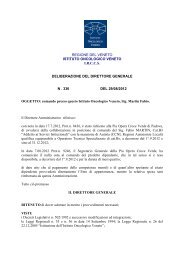SCIENTIFIC REPORT 2010 - 2011 - IOV
SCIENTIFIC REPORT 2010 - 2011 - IOV
SCIENTIFIC REPORT 2010 - 2011 - IOV
Create successful ePaper yourself
Turn your PDF publications into a flip-book with our unique Google optimized e-Paper software.
aNalySiS Of ThE prOGNOSTiC aND prEDiCTivE impaCT Of<br />
EGfr aND kraS muTaTiONS, aND Of EGfr fiSh iN<br />
aDvaNCED luNG aDENOCarCiNOma<br />
Principal Investigator: Adolfo Favaretto<br />
The non-small cell lung cancer (NSCLC) has demonstrated<br />
considerable heterogeneity of biological and clinical behavior.<br />
Reversible inhibitors of EGFR have proven effective in a group of<br />
patients with specific clinical and molecular features. Mutations in<br />
the tyrosine domain of EGFR were found to be the best predictor<br />
in terms of objective response and PFS, while FISH for EGFR<br />
seems to identify a larger group of patients who might benefit<br />
from treatment. KRAS mutations are associated with failure to<br />
respond to such therapy. The three molecular markers will be<br />
analyzed retrospectively in patients with stage IIIB and IV NSCLC<br />
undergoing surgery for diagnostic or therapeutic purposes; the<br />
patients will be selected based on the presence of at least one of<br />
the clinical features which appear to be predictive of response to<br />
EGFR inhibitors (non-smoker status, female). The purpose of this<br />
study is to determine whether mutations in the tyrosine domain<br />
of EGFR or gene amplifications evaluated by FISH analysis can<br />
confirm their predictive value in a selected population of patients<br />
with clinical features indicative of response to inhibitors of EGFR<br />
tyrosine kinases, and to assess their prognostic value in a specific<br />
clinical context. Samples were collected from 67 patients with<br />
lung adenocarcinoma. Mutational analysis of EGFR (exons 18-<br />
21), KRAS (exon 2) and FISH analysis for EGFR are ongoing.<br />
The overall survival and disease-free survival will be analyzed in<br />
relation to the molecular findings to investigate their prognostic<br />
significance. The influence of treatment with inhibitors of EGFR<br />
on overall survival and disease-free survival in different patient<br />
groups will then be analyzed.<br />
EvaluaTiON Of CirCulaTiNG TumOr CEllS (CTC)<br />
aND ENDOThElial prOGENiTOr CEllS (EpC) aS a<br />
prOGNOSTiC faCTOr iN lOCally aDvaNCED luNG<br />
CaNCEr (NSClC)<br />
Principal Investigator: Adolfo Favaretto<br />
Patients with locally advanced NSCLC have a median survival<br />
of about 1 year, and at 3 years about 20% are still alive. Aim of this<br />
study is to assess whether two cell markers could partially explain<br />
THE DEPARTMENTS - DEPARTMENT OF CLINICAL ONCOLOGY<br />
51<br />
this biological heterogeneity. CTC are present in many metastatic<br />
solid tumors. Their measurement in breast cancer has a prognostic<br />
and predictive value. EPC are cells derived from bone marrow and<br />
may play an important proangiogenetic role in the early growth<br />
of metastases. In 30 NSCLC patients we plan to count CTC<br />
and EPC at the beginning and at the end of concurrent chemoradiotherapy.<br />
In the case of sequential therapy, the count is also<br />
planned at the end of each treatment. The CTC will be evaluated<br />
with the CellSearch (Veridex, LLC, Warren, NJ) system.<br />
To this end, 15 ml of peripheral blood are incubated with<br />
magnetic nanoparticles conjugated with monoclonal antibody<br />
to the cell surface marker EpCAM, specific for epithelial cells.<br />
Through a magnetic field, EpCAM positive cells are selected<br />
and labeled with antibodies specific for white blood cells (anti-<br />
CD45) and epithelial cells (anti-cytokeratin 8, 18, 19) and a<br />
specific marker for cell nuclei (DAPI). A CTC, by definition,<br />
must express EpCAM, have a nucleus (DAPI positivity), and<br />
express markers for epithelial cells but not leukocytes. EPC are<br />
defined as endothelial cells in the peripheral blood expressing<br />
C-kit, VEGFR2, VE-cadherin but not expressing CD11b. Up to<br />
now, 6 patients with locally advanced NSCLC were enrolled and<br />
completed the counting of CTC and EPC.<br />
TumOr markErS fOr aDENOCarCiNOma Of ThE<br />
ESOphaGuS aND CarDiaS. a rETrOSpECTivE STuDy<br />
Principal Investigator: Vanna Chiarion-Sileni<br />
Tumor markers may correlate with the presence or progression<br />
of cancer. In cancers of the colon and pancreas, the predictive<br />
and prognostic value of CEA and Ca199 are defined, whereas<br />
for cancers of the esophagus and cardias only a few studies<br />
have evaluated the significance of their increase in the natural<br />
history of disease. The purpose of this study is to evaluate, both<br />
retrospectively and prospectively in patients treated from 1998<br />
with cardias gastric cancer, the significance and predictive value<br />
of CEA and Ca199 and their possible prognostic and predictive<br />
role.<br />
Data collection began in March <strong>2010</strong> and will continue until<br />
a suitable number of patients to obtain statistical significance will<br />
be reached. In case of evidence of a predictive and/or prognostic<br />
role, a prospective validation study will be proposed by the Italian<br />
Research Group on Biomarkers.


